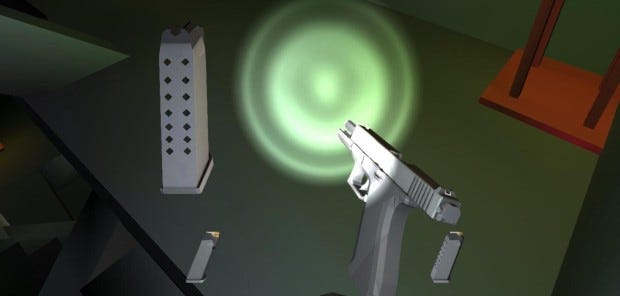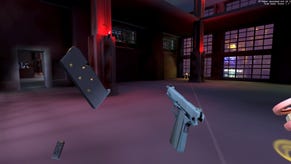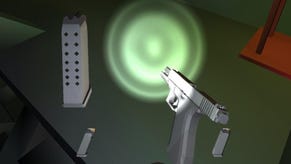Give Me More Expressive Actions In Videogames, Please
Press H To Read Thoughtfully
Receiver is a first-person shooter made in just seven days. It takes place on a set of grey rooftops sparsely populated by turrets and flying robots. Your goal is to collect cassette tapes from randomised locations, and each one contains a nebbish voice coldly reciting instructions and explanations of the game's hard-boiled scifi setting.
It's austere and £3/$5, yet it's also one of my favourite roleplaying games. Not because of a character creator or a stats sheet or quests. Receiver doesn't have any of those things. It's one of my favourite roleplaying games because it has a lot of buttons. A needless amount.
I want all games to have more needless buttons.
I've played Receiver for about half a dozen hours, and it's impressive the ways in which it wrings atmosphere and character from its limited components. The game has been updated and expanded slightly since the original build, created for the 7-Day FPS challenge, but it's still a tight package.
If you've played the game, or you play it for the first time after reading this, it's the guns you'll notice first. In each life - and you'll die a lot - you start with a random type of handgun, a random number of magazines and bullets for that handgun, and a random chance of having a flashlight.
What sets these pistols apart from other games is that you control each function of the weapon via a distinct button press.
If I was to put it simply, I'd say that in most games you press R to reload, while in Receiver you press Q, E, R, T, Z and V to feel like a world-weary cyberpunk hero.
But let's not put it simply.
If you want to reload one of Receiver's three handguns, then you press E to remove the magazine, and then tilde (`) to holster the gun. You press Z multiple times to slip any spare bullets you've found into the magazine. Then you get your gun back out, press Z to insert the magazine back inside, and hit T to load the chamber. Before you can fire, you'll also want to press V to turn the safety off or cycle between firing modes, and pull back the hammer with F.
This greater fidelity of simulation is normally described as "realistic", and it extends to the game's violent machinery, each of which is simulated as individual components: motors, cameras, ammo packs. But realism is not why these systems are interesting. If anything, in the case of your guns, abstracting your actions to individual button press feels less realistic. It's a reminder of all the little ways in which pressing a button is not at all like sliding a bullet into a magazine.
Instead the button presses help you embody your role within the game in a way that's fun and exhilarating.
To begin with, you'll spend a lot of time looking at the in-game help screen. Eventually you'll start slowly poking at the buttons, and you'll make mistakes.
You'll drop magazines on the floor.
You'll eject perfectly good bullets off rooftops.
You'll die because you tried to fire a weapon before loading a bullet into the chamber.
But then, over time, you'll start to get better. You'll remember which buttons to push and when. Within your first hour of play - and it doesn't take any longer than that - you'll be handling the weapon in your hands from memory.
You'll feel expert. You'll feel like exactly the kind of person who might survive in the science-fiction world described through Receiver's cassette tapes. The type of person who might run across rooftops, fighting machines.
At that point, each action becomes expressive. Loading a bullet into a chamber before attacking something isn't just functional anymore. It's business-like. I think a lot about the way games feel, but Receiver is one of the few games where individual actions have a tone.
The tone changes depending on the situation. When that electric robo-bastard is crackling away around a corner, trying to get at you, and you need to reload, it's terrifying. Fuckfuckfuck-remove the magazine-fuckfuckfuck-put new bullets in the magazine-fuckfuckfuck-drop the magazine on the floor because you pressed the wrong button-FUCKFUCKFUCKFUCKFUCK-die.
In other words, there's now an actual in-game distinction between panicked reloading and deliberate, calm reloading. The physicality of the weapon simulation expands the player's vocabulary.
Alright, look at this.
Die Hard is a pretty violent movie. John McClane kills a lot of people in it. But the poster isn't Willis firing at some European mercenaries. He's not even aiming. It's him with his back against the wall, looking pensive, listening, his gun up by his face. He looks stressed out, but ready for something, and that's cool enough.
Receiver's more complicated gun handling gets you a couple steps closer to living that role than most games - you can arguably hold your weapon pensively in it - but it's only enough of a taste that I'm hungry for more.
The last ten years have given us a few innovations as far as re-creating the staging and choreography of action scenes. Gears of War's vacuum-like button for throwing your back against cover is one. Blind-firing over and around cover is another. Bruce Willis did those. I like doing them, too.
This is also, as a slight aside, why Counter-Strike: Global Offensive's "look at weapon" button is so funny to me. It's not that it's a slightly forced way to justify custom weapon skins. It's that it's an expression of affection. I imagine every Counter-Terrorist and Terrorist smiling dimly to themselves as they gaze upon the pretty colours in between doing murders.
Please don't think this is just about guns, either.
Firstly, because in Receiver's case, the same applies to your need to keep tapping W if you want to sprint. Second, because I don't think it needs to even be limited to only practical actions. Receiver is a nighttime cyberpunk fantasy set on a bunch of cold grey rooftops. I want buttons designed solely to help me inhabit that role. I want 'Press J to take long drag on cigarette'. I want 'Press K to look at city skyline and deliver brooding soliloquy'. If idle animations are the way game artists communicate character in between moments of player input, then I want player input to be able to communicate character in the same way.
It would hurt consistency between different games and their control schemes, but it wouldn't matter. You could treat a lot of these buttons as optional extras, there for those who want to perform their role a little more fully. Bonuses for the people who want a button to extend and retract Adam Jensen's face-embedded sunglasses as well as his fist-chisels.
In any case, having to read the key bindings screen in Receiver is a small price for what you get in return.

















